Currently, there are two popular models of hardware wallets for storing your crypto assets: Trezor and Ledger. These wallets are designed to provide a secure and convenient way to store your cryptocurrencies.
Trezor and Ledger are both open-source wallets, which means their software is publicly available and can be audited by the community for security. They offer similar features, such as support for a wide range of cryptocurrencies and the ability to manage your wallet through a desktop or mobile app.
However, there are also some key differences between Trezor and Ledger. One notable difference is the design of the wallets. Trezor wallets use physical buttons for navigation and confirmation, while Ledger wallets have a touchscreen. Some users prefer the buttons for their simplicity and tactile feedback, while others find the touchscreen more intuitive.
Another difference is the materials used in the construction of the wallets. Trezor wallets are made of plastic, while Ledger wallets are made of stainless steel. The steel construction gives Ledger wallets a more durable and premium feel, but both wallets are designed to withstand physical damage.
When it comes to security, both Trezor and Ledger offer industry-leading features. They use a combination of encryption and offline storage to keep your private keys secure. Both wallets support the use of a passphrase for an additional layer of protection, and both companies regularly release updates to address any security vulnerabilities that may arise.
In terms of setup and ease of use, both Trezor and Ledger have streamlined processes that make it easy to get started. However, some users may find the setup process for Ledger wallets to be slightly more straightforward, as they come with a pre-installed firmware and offer a guided setup wizard.
Overall, both Trezor and Ledger are trusted and reputable companies that offer top-of-the-line security for your crypto assets. The best choice depends on your personal preferences and needs. Whether you prefer the simplicity of buttons or the touchscreen, the plastic or steel construction, both Trezor and Ledger will provide you with a secure and reliable way to store your cryptocurrencies.
- Trezor vs Ledger Pricing
- At a Glance
- Trezor vs Ledger Wallet Features
- Models
- Difference in Features
- Open-Source Support
- Popular Models
- Materials
- The Final Verdict
- Trezor vs Ledger Ease of Use
- Trezor vs Ledger Mobile App
- Trezor Mobile App
- Ledger Mobile App
- Conclusion
- Final Verdict
- Ledger
- Methodology
- Trezor vs Ledger Currencies
- Trezor vs Ledger Security
- Frequently Asked Questions:
- Which is better, Trezor or Ledger?
- What are the main differences between Trezor and Ledger?
- Can I use Trezor or Ledger with my smartphone?
- Is it difficult to set up Trezor or Ledger?
- Which wallet offers better customer support, Trezor or Ledger?
- Video:
- Ledger Hardware Wallet Risks!? Here’s Everything We Know!
Trezor vs Ledger Pricing
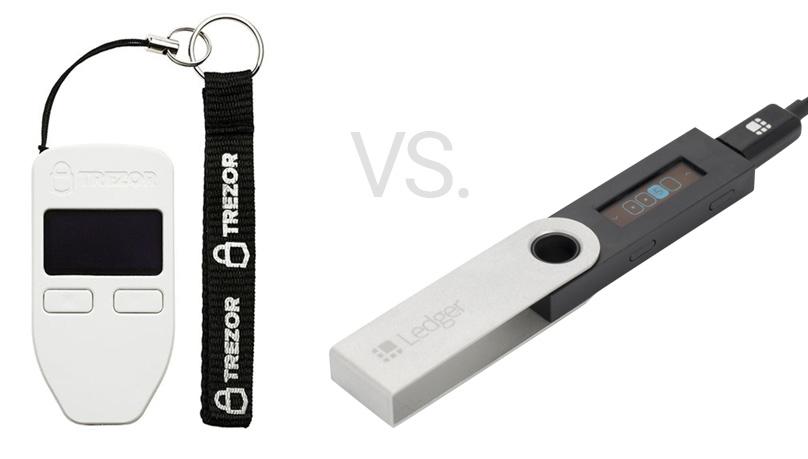
When it comes to the pricing of crypto wallets, both Trezor and Ledger offer competitive options to suit different needs and budgets.
Trezor currently offers two models: Trezor One and Trezor Model T. The Trezor One is the more affordable option, priced at around $59. It comes with a black plastic case, a small screen, and two buttons for navigation. On the other hand, the Trezor Model T is a more advanced and expensive option priced at around $169. It features a larger color touchscreen and a more modern design.
Ledger, on the other hand, offers a variety of models to choose from. The Ledger Nano S is their entry-level model, priced at around $59. It comes with a small screen and two buttons, similar to the Trezor One. The Ledger Nano X is their more premium option, priced at around $119. It offers a larger screen and Bluetooth connectivity for mobile use.
One notable difference between Trezor and Ledger is their casing material. Trezor wallets use a plastic casing, while Ledger wallets use a stainless steel casing. This difference in materials may appeal to users who prefer a more durable and robust design.
Both Trezor and Ledger wallets support a wide range of cryptocurrencies, including popular ones like Bitcoin, Ethereum, and Litecoin. However, Ledger currently supports a larger number of supported coins compared to Trezor.
Another difference is that Trezor is an open-source wallet, meaning that its software is publicly available and can be audited by the community for security. Ledger, on the other hand, offers proprietary software that is not open-source. Some users may prefer the transparency and security auditability that an open-source wallet like Trezor provides.
In terms of setup, both Trezor and Ledger offer straightforward processes that are easy to follow. They come with clear instructions and user-friendly interfaces to guide users through the setup process.
Overall, both Trezor and Ledger offer reliable and secure crypto wallets with their own unique features and pricing options. The decision between the two ultimately depends on individual preferences and needs.
At a Glance
In the world of cryptocurrency, two popular hardware wallet models stand out: Trezor and Ledger. Both Trezor and Ledger wallets are trusted and widely used by crypto enthusiasts and investors.
Trezor and Ledger are cold wallets, which means they keep your crypto assets offline, adding an extra layer of security compared to online wallets. They are both open-source, meaning the software code is publicly available for anyone to review, which enhances transparency and security.
Trezor offers two different models: Trezor One and Trezor Model T. Both models support a wide range of cryptocurrencies, including Bitcoin, Ethereum, Litecoin, and many more. They also provide a user-friendly interface with buttons and a screen for easy navigation and transaction confirmation.
On the other hand, Ledger offers several different wallet models. The most popular ones are Ledger Nano X and Ledger Nano S. Just like Trezor, Ledger wallets support various cryptocurrencies and have buttons and screens for enhanced usability.
One key difference between Trezor and Ledger is their setup process. Trezor wallets require a computer connection to set up and manage the device, while Ledger wallets can be managed through a mobile app, making them a more convenient option for those who prefer mobile usage.
In terms of security, both Trezor and Ledger wallets are built with top-notch protection features. Trezor wallets use a durable case made of plastic, while Ledger wallets use a stainless steel case that provides extra durability and protection.
When it comes to price, Trezor and Ledger offer different models at various price points, allowing users to choose the one that fits their budget and preferences.
In conclusion, both Trezor and Ledger are reputable and reliable companies that provide high-quality crypto wallets. The choice between them will depend on personal preferences, including the supported cryptocurrencies, ease of use, setup process, and design. Regardless of which wallet you choose, using a hardware wallet is crucial to keep your crypto assets secure.
Trezor vs Ledger Wallet Features
When it comes to securing your crypto assets, two of the most popular companies in the market are Trezor and Ledger. Both companies offer top-of-the-line crypto wallets that are designed to keep your digital currencies safe from hackers and other unauthorized access.
When compared side by side, it’s clear that both Trezor and Ledger have their own unique features that make them stand out from each other.
Models
Trezor currently offers two models of their cold wallets, the Trezor One and the Trezor Model T. On the other hand, Ledger has several models including the Ledger Nano S, Ledger Nano X, and the Ledger Blue.
Difference in Features
One major difference between Trezor and Ledger is the type of security they use. Trezor wallets rely on a setup process that involves physical buttons, while Ledger wallets use a more advanced chip technology called Secure Element.
Another difference is the type of cryptocurrencies each wallet supports. Trezor wallets support a wide range of cryptocurrencies, including Bitcoin, Ethereum, and many more. Ledger, on the other hand, supports over 1,000 cryptocurrencies.
Open-Source Support
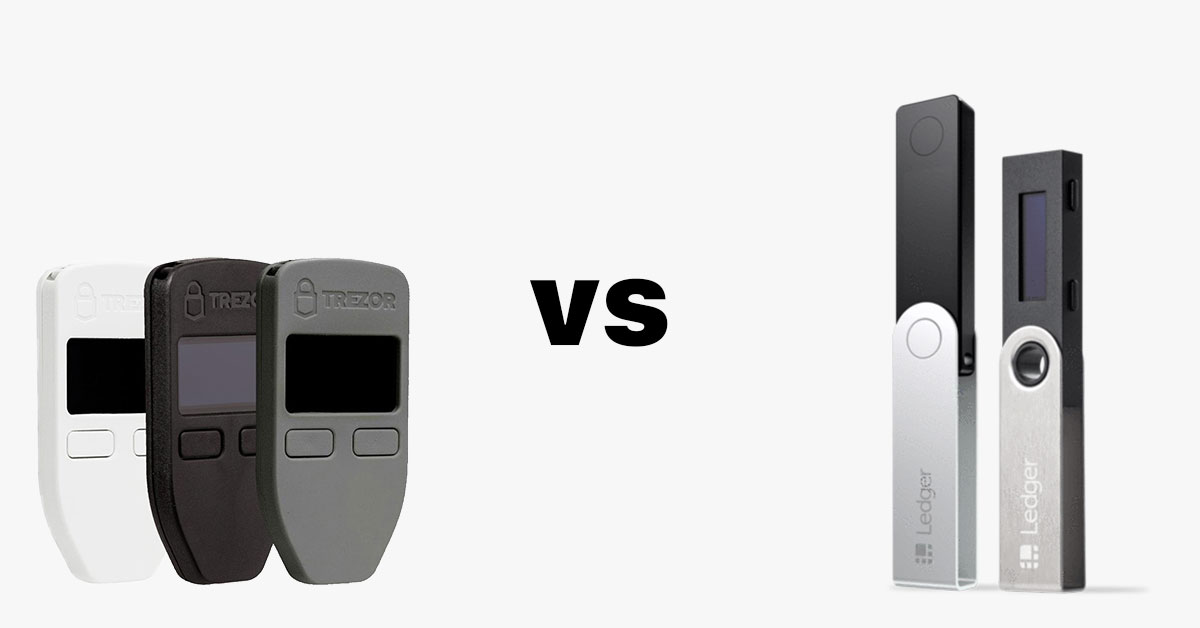
Both Trezor and Ledger are open-source companies, meaning that their products are transparent and can be audited by anyone. This gives users an added level of confidence in the security of their wallets.
Popular Models
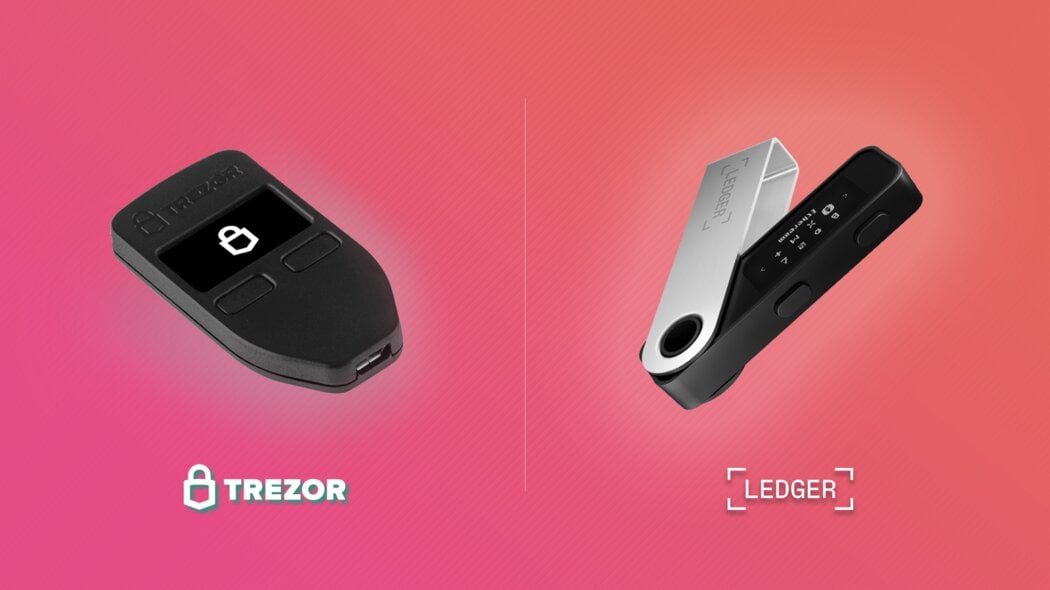
Among the popular models, Trezor offers the Trezor Model T, which features a large color touchscreen and a sleek design. Ledger, on the other hand, offers the Ledger Nano X, which is known for its Bluetooth connectivity and improved mobile support.
Materials
When it comes to the materials used in their wallets, Trezor wallets are made of plastic, while Ledger wallets are made of stainless steel. This difference in materials may appeal to different types of users based on their personal preferences.
The Final Verdict
In summary, Trezor and Ledger both offer excellent features and security measures to keep your crypto assets safe. The choice between the two ultimately depends on your specific needs and preferences. It’s recommended to carefully compare the models and features of each company before making a decision.
Trezor vs Ledger Ease of Use

When it comes to ease of use, both Trezor and Ledger offer user-friendly interfaces and straightforward setup processes. However, there are some differences between the two models in terms of their usability.
Trezor:
- Trezor currently offers two models: Trezor One and Trezor Model T. Both models have a simple and intuitive user interface, making it easy for beginners to navigate.
- Trezor One has a small screen and two buttons, while Trezor Model T has a larger touch screen.
- The setup process for Trezor involves connecting the device to a computer, installing the necessary software, and following the step-by-step instructions on the device’s screen.
- Trezor uses an open-source firmware, allowing the crypto community to audit and verify its security.
Ledger:
- Ledger offers several models, including Ledger Nano S and Ledger Nano X. Both models are known for their compact design and simplicity.
- Ledger Nano S has a small screen and two buttons, while Ledger Nano X has a larger color screen.
- The setup process for Ledger involves connecting the device to a computer, installing the Ledger Live software, and following the on-screen instructions.
- Ledger also uses an open-source firmware, ensuring transparency and security.
Overall, both Trezor and Ledger provide user-friendly interfaces and straightforward setup processes. The main difference lies in the design of their models and the size of their screens. Depending on personal preferences, users can choose between Trezor’s two-button or touch screen interface or Ledger’s two-button or color screen interface.
Trezor vs Ledger Mobile App
Trezor and Ledger are two of the most popular companies that offer crypto hardware wallets. While both Trezor and Ledger have physical devices, they also have mobile apps that allow users to access their wallets and manage their crypto assets on the go. In this article, we will compare the Trezor mobile app with the Ledger mobile app and discuss their differences.
Trezor Mobile App
Trezor offers a mobile app that is supported on both iOS and Android devices. The Trezor mobile app allows users to manage their Trezor wallets directly from their smartphones. This means that users can check their balances, send and receive crypto, and access their transaction history all from the convenience of their mobile devices.
One of the main advantages of the Trezor mobile app is that it supports all Trezor models, including the Trezor Model T and the Trezor One. This means that users can use the Trezor mobile app with their existing Trezors, regardless of the model they own. The app also supports a wide range of cryptocurrencies, including popular ones like Bitcoin, Ethereum, and Litecoin.
The Trezor mobile app is easy to set up. Users simply need to connect their Trezor device to their mobile device using a USB cable or bluetooth, and they can start managing their crypto assets right away. The app also offers additional security features like biometric login and passphrase support, ensuring that users’ funds are kept secure.
Ledger Mobile App

Ledger also has a mobile app that is available on iOS and Android devices. The Ledger mobile app, called Ledger Live, allows users to manage their Ledger wallets from their smartphones. Similar to the Trezor mobile app, Ledger Live enables users to check their balances, send and receive crypto, and view their transaction history.
However, one key difference between the Trezor and Ledger mobile apps is that the Ledger mobile app currently only supports Ledger Nano X, which is Ledger’s latest and most advanced hardware wallet. This means that if you own a Ledger Nano S or any other older model, you will not be able to use the Ledger mobile app.
Like Trezor, the Ledger mobile app also supports a wide range of cryptocurrencies, including popular ones like Bitcoin, Ethereum, and Ripple. The app is user-friendly and offers features like multiple accounts and portfolio management.
Similar to the Trezor mobile app, the Ledger mobile app also provides additional security features like biometric login and passphrase support. Ledger Live is also open-source, which means that the code is accessible to the public and can be audited for security purposes.
Conclusion
In conclusion, both the Trezor and Ledger mobile apps provide convenient ways for users to manage their crypto assets on the go. The main difference is that the Trezor mobile app is compatible with all Trezor models, while the Ledger mobile app currently only supports the Ledger Nano X. Additionally, the Trezor mobile app supports a wider range of cryptocurrencies compared to the Ledger mobile app. Nonetheless, both apps offer essential features like balance checking, sending and receiving crypto, and additional security measures to ensure the safety of users’ funds.
Final Verdict
In conclusion, when it comes to choosing between Trezor and Ledger, both wallets are well-known in the crypto community and offer a high level of security for cold storage of cryptocurrencies.
Trezor, being the original hardware wallet on the market, uses an open-source model and supports a wide range of cryptocurrencies compared to Ledger. It is a popular choice among users who prefer a more customizable and user-friendly interface.
On the other hand, Ledger is also a widely supported hardware wallet that is currently more popular among users. It offers a sleek and minimalistic design and provides a seamless setup process. Their wallets are known to have a durable stainless steel case, which makes them more resistant to physical damage.
However, the major difference between the two companies is their button design. Trezor has physical buttons, which some users may find more secure, while Ledger has touch-sensitive buttons. This ultimately comes down to personal preference.
Overall, both Trezor and Ledger are reliable choices for cold storage of cryptocurrencies. It is important to note that the final decision depends on user preferences, including the number of supported cryptocurrencies, ease of use, and the level of security desired.
Ledger

Ledger is a popular hardware wallet for storing crypto assets securely. It is one of the main competitors of Trezor and offers various models to meet different user needs.
Setup:
Ledger wallets are relatively easy to set up. Users have to install the Ledger Live application on their computer or mobile device and follow the step-by-step instructions provided. Ledger wallets currently support a wide range of cryptocurrencies, including Bitcoin, Ethereum, and many others.
Difference compared to Trezor:
The main difference between Ledger and Trezor lies in their design and supported models. While Trezor provides a single model, Ledger offers several different models, such as Ledger Nano S, Ledger Nano X, and Ledger Blue, allowing users to choose the one that suits their preferences and requirements.
Security:
Ledger wallets prioritize security and utilize advanced security features to protect users’ crypto assets. They are built with a robust security layer, including a secure chip, which stores the user’s private keys securely. Ledger wallets also offer a secure element and are developed to resist a wide range of attacks. Additionally, Ledger wallets can be secured with a PIN code or passphrase to provide an extra layer of protection.
Open-source:
Ledger wallets rely on open-source software, which means that their code is publicly available for review and scrutiny. This transparency increases trust in the security of the wallets, as it allows the community to verify the implementations and identify potential vulnerabilities.
Cold storage and convenience:
Ledger wallets can be used as cold storage devices, meaning that they are not connected to the internet during the transaction process, which enhances security against online threats. However, Ledger wallets also provide a convenient user experience by allowing users to access their crypto assets easily through the Ledger Live application.
Steel and buttons:
Ledger wallets come with a durable stainless-steel case, which adds physical protection to the device. The models also include buttons that are used to navigate through the wallet’s interface. These buttons provide enhanced security, as they require physical interaction for approving transactions, reducing the risk of unauthorized transactions.
Supported cryptocurrencies:
Ledger wallets support a wide range of cryptocurrencies, including Bitcoin, Ethereum, Ripple, Litecoin, and many others. The Ledger Live application allows users to manage their cryptocurrencies in a user-friendly interface and provides regular updates and new features.
| Ledger models | Trezor models |
|---|---|
| Ledger Nano S | Trezor One |
| Ledger Nano X | Trezor Model T |
| Ledger Blue |
Both Ledgers and Trezors are well-known and reputable companies in the crypto industry, offering secure solutions for storing crypto assets. The choice between Ledger and Trezor ultimately depends on the user’s specific needs and preferences.
Methodology
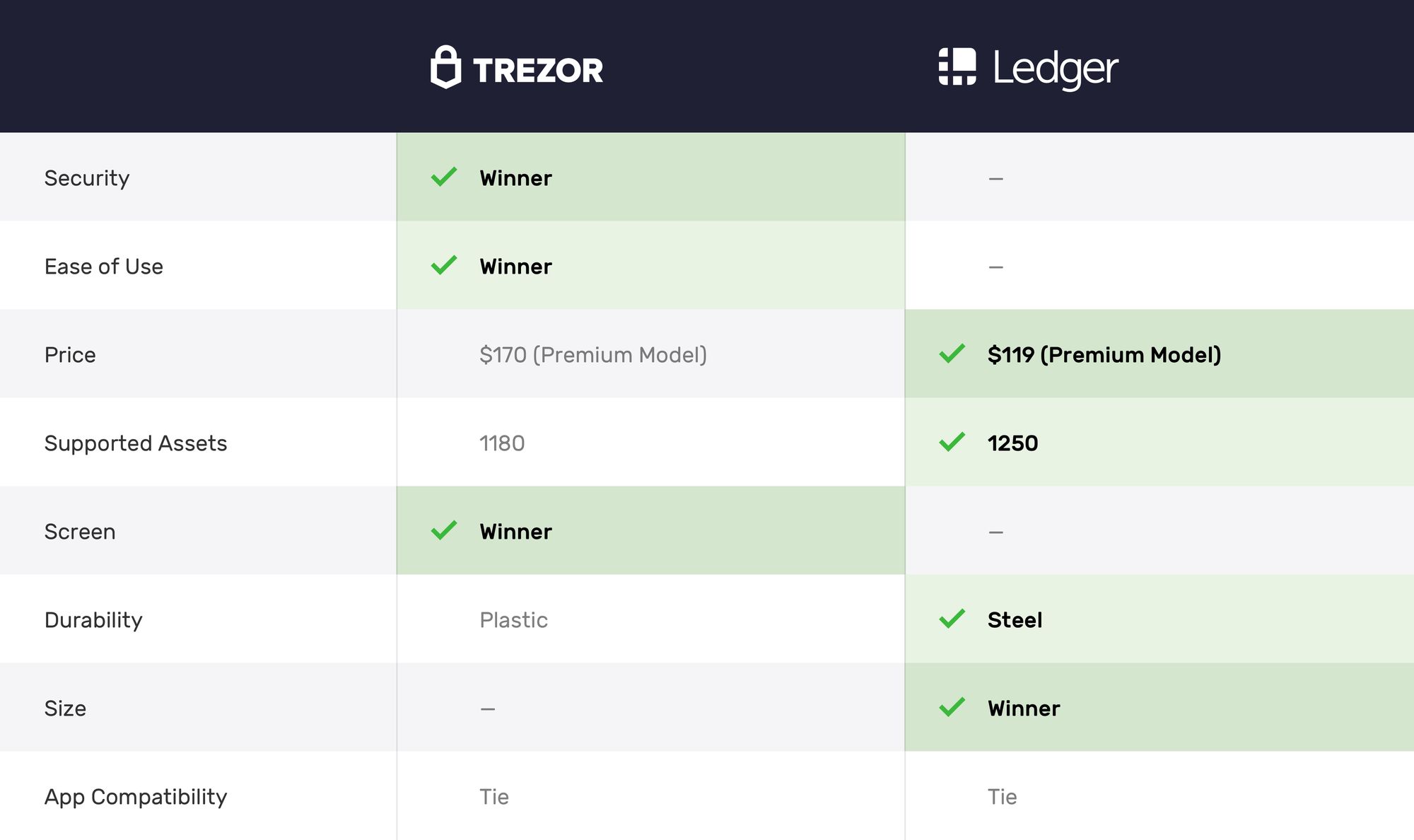
In order to evaluate the differences between Trezor and Ledger crypto wallets, we conducted a thorough analysis of their features and performance. The methodology used for this comparison is as follows:
- Hardware design: We examined the physical design of both Trezor and Ledger wallets. Trezor wallets are made of plastic, while Ledger wallets use a stainless steel cover. We took into consideration the durability and robustness of the wallets.
- Supported currencies: We compared the range of crypto currencies that can be stored and managed on each wallet. Trezor supports more than 1,000 cryptocurrencies, while Ledger wallets currently support around 30.
- User interface: We evaluated the user interface of both wallets, including the ease of navigation and accessibility of features. Trezor uses a straightforward interface with two buttons and a small screen, while Ledger offers a larger screen and more buttons for user interaction.
- Security features: We assessed the security measures implemented by both companies. Trezor and Ledger both utilize open-source software and offer strong encryption algorithms. We also examined the cold storage capabilities of each wallet.
- Model options: We compared the different models available for purchase. Trezor offers multiple models, including the Trezor One and Trezor Model T, while Ledger offers the Ledger Nano S and Ledger Nano X.
- Popularity and support: We took into account the reputation and support offered by the companies behind each wallet. Trezor and Ledger are both well-known and trusted brands in the crypto community, but Trezor has been in the market for a longer period of time and has a larger user base.
By analyzing these factors, we were able to obtain a comprehensive understanding of the differences between Trezor and Ledger wallets. The information gathered during this analysis can help users make an informed decision when choosing the best crypto wallet for their needs.
Trezor vs Ledger Currencies

Both Trezor and Ledger offer excellent cryptocurrency wallets that are popular among crypto enthusiasts. They are designed to securely store various digital currencies, ensuring the safety of your funds. Although there are similarities between the two, there are also some differences to consider when choosing the best wallet for your needs.
Trezor:
Trezor is a well-established company that has been in the crypto wallet market for a while. They offer different models of their wallet, including Trezor One and Trezor Model T. Trezor wallets are known for their security features and ease of use.
- Trezor wallets support a wide range of cryptocurrencies, including Bitcoin, Ethereum, Litecoin, and many others.
- They use a secure element chip to store private keys and protect them from hacking attempts.
- Setting up a Trezor wallet is straightforward, with user-friendly buttons and an intuitive interface.
Ledger:
Ledger is another reputable company in the crypto wallet market, offering different models of their wallets, such as Ledger Nano S and Ledger Nano X. Ledger wallets are also known for their security features and user-friendly interface.
- Ledger wallets support a wide range of cryptocurrencies, including Bitcoin, Ethereum, Ripple, and many others.
- They use a custom operating system called BOLOS and a secure element chip to ensure the safety of your private keys.
- Setting up a Ledger wallet is easy, thanks to the clear instructions provided by the company.
Difference:
The main difference between Trezor and Ledger is the operating system they use. Trezor wallets are based on an open-source platform, while Ledger wallets use their custom operating system. Some users prefer open-source wallets, as they allow for more transparency and community involvement in the development process.
Currently Supported Currencies:
| Trezor Currencies | Ledger Currencies |
|---|---|
| Bitcoin | Bitcoin |
| Ethereum | Ethereum |
| Litecoin | Ripple |
| Ripple | Litecoin |
| And many more… | And many more… |
Both Trezor and Ledger offer a wide range of supported cryptocurrencies, allowing you to manage multiple digital assets securely. Whether you choose Trezor or Ledger, you can be confident that your crypto funds are kept safe in a cold storage wallet.
Trezor vs Ledger Security
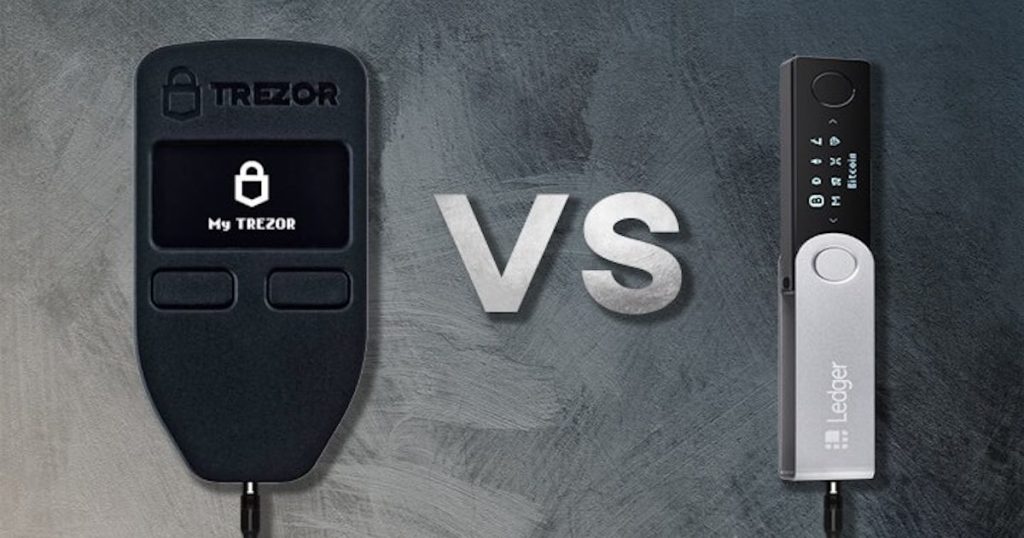
When it comes to the security of your crypto assets, both Trezor and Ledger offer robust solutions. However, there are some differences in their approach and features that you should consider when choosing a cryptocurrency wallet.
Trezor Security:
- Trezor is an open-source hardware wallet that has gained popularity among crypto enthusiasts.
- Trezor wallets use a secure chip to store private keys and offer protection against physical attacks.
- The setup process of Trezor wallets involves connecting the device to your computer and following the instructions provided by the web-based interface.
- Trezor wallets have physical buttons that you need to press to confirm transactions, adding an extra layer of security.
- Trezor offers both cold storage and hot wallet options, allowing you to choose the level of security that suits your needs.
Ledger Security:
- Ledger is another popular hardware wallet brand that is known for its security features.
- Ledger wallets also use a secure chip to store private keys and protect against physical attacks.
- Unlike Trezor, Ledger wallets offer a wider range of models, including those made of stainless steel, which provide additional durability.
- Ledger wallets are supported by their own desktop and mobile applications, which offer a user-friendly interface for managing your crypto assets.
- Similar to Trezor, Ledger wallets have physical buttons for transaction confirmation.
Difference in Security:
The main difference in the security aspect between Trezor and Ledger lies in their design and the range of supported cryptocurrencies.
- Trezor wallets support a wide range of cryptocurrencies, including Bitcoin, Ethereum, and many others.
- Ledger wallets, on the other hand, support even more cryptocurrencies and tokens, making it a more versatile choice.
- Additionally, Ledger offers models like the Ledger Nano X, which allows you to manage your crypto assets on the go via Bluetooth connectivity.
In conclusion, both Trezor and Ledger provide top-notch security for storing your crypto assets. While Trezor is an open-source and user-friendly option, Ledger offers a wider range of models and supported cryptocurrencies. Ultimately, the choice between the two will depend on your specific needs and preferences.
Frequently Asked Questions:
Which is better, Trezor or Ledger?
The answer depends on your individual needs and preferences. Both Trezor and Ledger offer excellent security features and are widely trusted in the crypto community.
What are the main differences between Trezor and Ledger?
The main differences between Trezor and Ledger are in their design, user interface, and supported cryptocurrencies. Trezor has a more minimalist design and supports a wider range of cryptocurrencies, while Ledger has a sleeker design and a more user-friendly interface.
Can I use Trezor or Ledger with my smartphone?
Yes, both Trezor and Ledger can be used with smartphones. They have mobile apps that allow you to manage your crypto assets on the go.
Is it difficult to set up Trezor or Ledger?
No, setting up Trezor or Ledger is relatively simple. Both wallets come with clear instructions and easy-to-follow setup processes.
Which wallet offers better customer support, Trezor or Ledger?
Both Trezor and Ledger have good customer support. They provide detailed documentation, tutorials, and FAQs on their websites, and you can also reach out to their support teams via email or live chat.
Video:
Ledger Hardware Wallet Risks!? Here’s Everything We Know!








